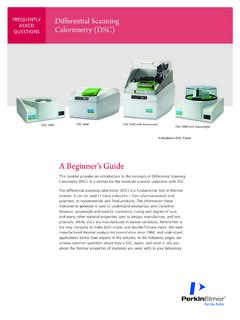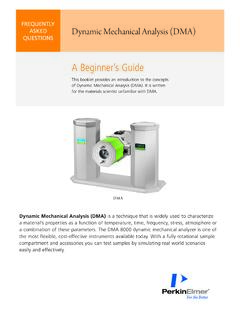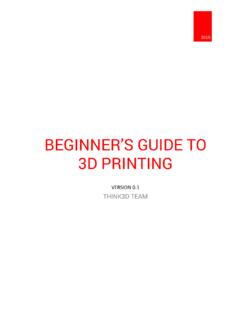Transcription of THE FREE BEGINNER’S GUIDE TO 3D PRINTING
1 THE FREE beginner S GUIDE TO 3D PRINTINGT able of ContentsChapter 02 : History of 3D PrintingChapter 03 : 3D PRINTING TechnologyChapter 04 : 3D PRINTING ProcessesChapter 05 : 3D PRINTING MaterialsChapter 06 : 3D PRINTING Global EffectsChapter 07 : 3D PRINTING Benefits & ValueChapter 08 : 3D PRINTING ApplicationsGlossary051019244048535772 Chapter 01 : Introduction: What is 3D PRINTING ?Welcome to 3 DPI s beginner s GUIDE to 3D PRINTING . Whether you are new to 3D PRINTING technology or just looking to close a few knowledge gaps, we re glad you stopped by. By now, most of us have heard, at some level, about the potential of 3D PRINTING . But with this GUIDE we are offering insights into the history and the reality of 3D PRINTING the processes, materials and applications as well as measured thoughts on where it might be heading. !We hope you ll find this to be one of the most comprehensive 3D PRINTING resources available, and that no matter what your skill level is, there will be plenty in here to meet your needs.
2 As an added bonus, we re working on a handy downloadable PDF version of the entire GUIDE , and hope to have that ready very soon. !Are you ready? Let s get started!3D PRINTING also known as additive manufacturing has been quoted in the Financial Times and by other sources as potentially being larger than the Internet. Some believe this is true. Many others urge that this is part of the extraordinary hype that exists around this very exciting technology area. So what really is 3D PRINTING , who generally uses 3D printers and what for?3D PRINTING Basics:! term 3D PRINTING covers a host of processes and technologies that offer a full spectrum of capabilities for the production of parts and products in different materials. Essentially, what all of the processes and technologies have in common is the manner in which production is carried out layer by layer in an additive process which is in contrast to traditional methods of production involving subtractive methods or moulding/casting processes.
3 Applications of 3D PRINTING are emerging almost by the day, and, as this technology continues to penetrate more widely and deeply across industrial, maker and consumer sectors, this is only set to increase. Most reputable commentators on this technology sector agree that, as of today, we are only just beginning to see the true potential of 3D PRINTING . 3 DPI, a reliable media source for 3D PRINTING , brings you all of the latest news, views, process developments and applications as they emerge in this exciting field. This overview article aims to provide the 3 DPI audience with a reliable backgrounder on 3D PRINTING in terms of what it is (technologies, processes and materials), its history, application areas and benefits.! What is 3D PRINTING ?!5 Introduction What is 3D PRINTING ?Technology has affected recent human history probably more than any other field. Think of a light bulb, steam engine or, more latterly, cars and aeroplanes, not to mention the rise and rise of the world wide web.
4 These technologies have made our lives better in many ways, opened up new avenues and possibilities, but usually it takes time, sometimes even decades, before the truly disruptive nature of the technology becomes apparent. !It is widely believed that 3D PRINTING or additive manufacturing (AM) has the vast potential to become one of these technologies. 3D PRINTING has now been covered across many television channels, in mainstream newspapers and across online resources. What really is this 3D PRINTING that some have claimed will put an end to traditional manufacturing as we know it, revolutionize design and impose geopolitical, economic, social, demographic, environmental and security implications to our every day lives? !The most basic, differentiating principle behind 3D PRINTING is that it is an additive manufacturing process. And this is indeed the key because 3D PRINTING is a radically different manufacturing method based on advanced technology that builds up parts, additively, in layers at the sub mm scale.
5 This is fundamentally different from! What is 3D PRINTING ?any other existing traditional manufacturing techniques. !There are a number of limitations to traditional manufacturing, which has widely been based on human labour and made by hand ideology rooting back to the etymological origins of the French word for manufacturing itself. However, the world of manufacturing has changed, and automated processes such as machining, casting, forming and moulding are all (relatively) new, complex processes that require machines, computers and robot technology. !However, these technologies all demand subtracting material from a larger block whether to achieve the end product itself or to produce a tool for casting or moulding processes and this is a serious limitation within the overall manufacturing process. !For many applications traditional design and production processes impose a number of unacceptable constraints, including the expensive tooling as mentioned above, fixtures, and the need for assembly for complex parts.
6 In addition, the! What is 3D PRINTING ?subtractive manufacturing processes, such as machining, can result in up to 90% of the original block of material being wasted. !In contrast, 3D PRINTING is a process for creating objects directly, by adding material layer by layer in a variety of ways, depending on the technology used. Simplifying the ideology behind 3D PRINTING , for anyone that is still trying to understand the concept (and there are many), it could be likened to the process of building something with Lego blocks automatically. !3D PRINTING is an enabling technology that encourages and drives innovation with unprecedented design freedom while being a tool-less process that reduces prohibitive costs and lead times. Components can be designed specifically to avoid assembly requirements with intricate geometry and complex features created at no extra cost. 3D PRINTING is also emerging as an energy-efficient technology that can provide environmental efficiencies in terms of both the manufacturing process itself, utilising up to 90% of standard materials, and throughout the product s operating life, through lighter and stronger design.
7 !In recent years, 3D PRINTING has gone beyond being an! What is 3D PRINTING ?industrial prototyping and manufacturing process as the technology has become more accessible to small companies and even individuals. Once the domain of huge, multi-national corporations due to the scale and economics of owning a 3D printer, smaller (less capable) 3D printers can now be acquired for under $1000. !This has opened up the technology to a much wider audience, and as the exponential adoption rate continues apace on all fronts, more and more systems, materials, applications, services and ancillaries are emerging.! of 3D PrintingCHAPTER!10 History of 3D PrintingThe earliest 3D PRINTING technologies first became visible in the late 1980 s, at which time they were called Rapid Prototyping (RP) technologies. This is because the processes were originally conceived as a fast and more cost-effective method for creating prototypes for product development within industry.
8 As an interesting aside, the very first patent application for RP technology was filed by a Dr Kodama, in Japan, in May 1980. Unfortunately for Dr Kodama, the full patent specification was subsequently not filed before the one year deadline after the application, which is particularly disastrous considering that he was a patent lawyer! In real terms, however, the origins of 3D PRINTING can be traced back to 1986, when the first patent was issued for stereolithography apparatus (SLA). This patent belonged to one Charles (Chuck) Hull, who first invented his SLA machine in 1983. Hull went on to co-found 3D Systems Corporation one of the largest and most! of 3D Printingprolific organizations operating in the 3D PRINTING sector today. !3D Systems first commercial RP system, the SLA-1, was introduced in 1987 and following rigorous testing the first of these system was sold in 1988. As is fairly typical with new technology, while SLA can claim to be the first past the starting post, it was not the only RP technology in development at this time, for, in 1987, Carl Deckard, who was working at the University of Texas, filed a patent in the US for the Selective Laser Sintering (SLS) RP process.
9 This patent was issued in 1989 and SLS was later licensed to DTM Inc, which was later acquired by 3D Systems. 1989 was also the year that Scott Crump, a co-founder of Stratasys Inc. filed a patent for Fused Deposition Modelling (FDM) the proprietary technology that is still held by the company today, but is also the process used by many of the entry-level machines, based on the open source RepRap model, that are prolific today. The FDM patent was issued to Stratasys in 1992. In Europe, 1989 also saw the formation of! of 3D PrintingEOS GmbH in Germany, founded by Hans Langer. After a dalliance with SL processes, EOS R&D focus was placed heavily on the laser sintering (LS) process, which has continued to go from strength to strength. Today, the EOS systems are recognized around the world for their quality output for industrial prototyping and production applications of 3D PRINTING . EOS sold its first Stereos system in 1990. The company s direct metal laser sintering (DMLS) process resulted from an initial project with a division of Electrolux Finland, which was later acquired by EOS.
10 !Other 3D PRINTING technologies and processes were also emerging during these years, namely Ballistic Particle Manufacturing (BPM) originally patented by William Masters, Laminated Object Manufacturing (LOM) originally patented by Michael Feygin, Solid Ground Curing (SGC) originally patented by Itzchak Pomerantz et al and three dimensional PRINTING (3DP) originally patented by Emanuel Sachs et al. And so the early nineties witnessed a growing number of competing companies in the RP market but only three of the originals remain today 3D Systems, EOS and Stratasys. !Throughout the 1990 s and early 2000 s a host of new technologies continued to be! of 3D Printingntroduced, still focused wholly on industrial applications and while they were still largely processes for prototyping applications, R&D was also being conducted by the more advanced technology providers for specific tooling, casting and direct manufacturing applications. This saw the emergence of new terminology, namely Rapid Tooling (RT), Rapid Casting and Rapid Manufacturing (RM) respectively.






